Hướng dẫn và ví dụ Java PushbackInputStream
1. PushbackInputStream
Đôi khi làm việc với một luồng đầu vào nhị phân (binary input stream) bạn cần đọc trước một vài bytes để xem điều gì sắp xảy ra, trước khi bạn có thể xác định cách diễn giải byte hiện tại, sau đó bạn có thể đẩy chúng trở lại. Lớp PushbackInputStream cho phép bạn làm điều đó.
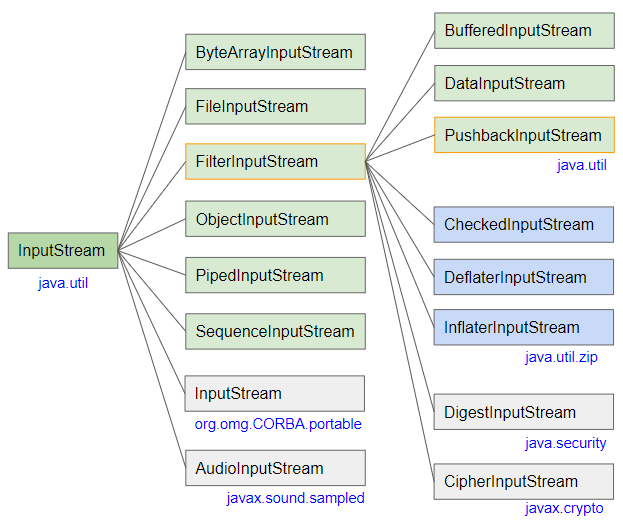
- InputStream
- BufferedInputStream
- SequenceInputStream
- FileInputStream
- ObjectInputStream
- ByteArrayInputStream
- PipedInputStream
- FilterInputStream
- AudioInputStream
- DataInputStream
- InflaterInputStream
- DigestInputStream
- DeflaterInputStream
- CipherInputStream
- CheckedInputStream
PushbackInputStream quản lý một đối tượng InputStream, đối tượng này sẽ đọc dữ liệu từ nguồn gốc (chẳng hạn file), đồng thời PushbackInputStream cũng quản lý một mảng byte - buffer.
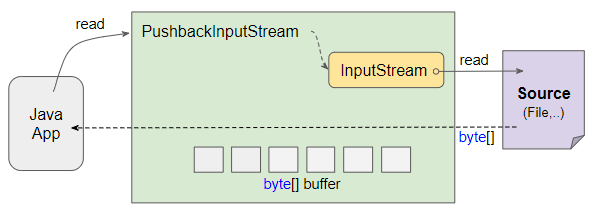
Tại thời điểm ban đầu, không có một byte nào được gán vào mảng buffer. Phương thức PushbackInputStream.read sẽ trả về các bytes từ InputStream.read.
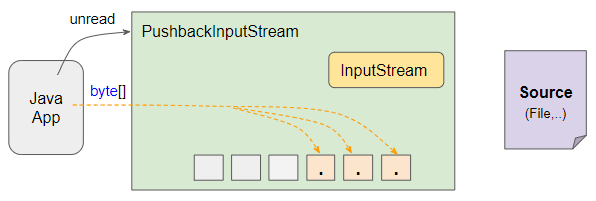
Nếu bạn gọi phương thức PushbackInputStream.unread để đẩy các bytes trở lại, chúng sẽ được lưu trữ trên mảng buffer.
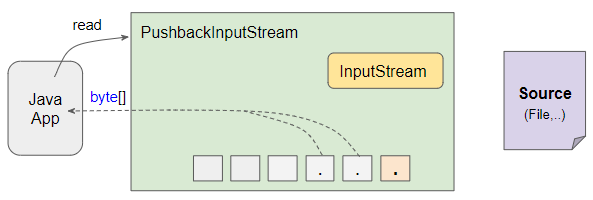
Trong lần tiếp theo, nếu bạn gọi phương thức PushbackInputStream.read, nó sẽ trả về các bytes đã được lưu trữ trên mảng buffer. Phương thức InputStream.read sẽ chỉ được gọi nếu không còn byte nào trên mảng buffer.
PushbackReader constructors
public PushbackReader(Reader in, int size)
public PushbackReader(Reader in)- Constructor PushbackInputStream(InputStream,int) tạo ra một đối tượng PushbackInputStream với mảng buffer có kích thước được chỉ định.
- Constructor PushbackInputStream(InputStream) tạo ra một đối tượng PushbackInputStream với mảng buffer có kích thước mặc định (size = 1).
2. Examples
Giả sử bạn lưu trữ tất cả dữ liệu của 3 hình ảnh vào một file duy nhất, chúng ngăn cách nhau bởi "@@@". Làm sao để đọc file này và ghi ra 3 file hình ảnh tương ứng với các dữ liệu?
..bytes..of..image1..@@@..bytes..of..image2..@@@..bytes..of..image3..

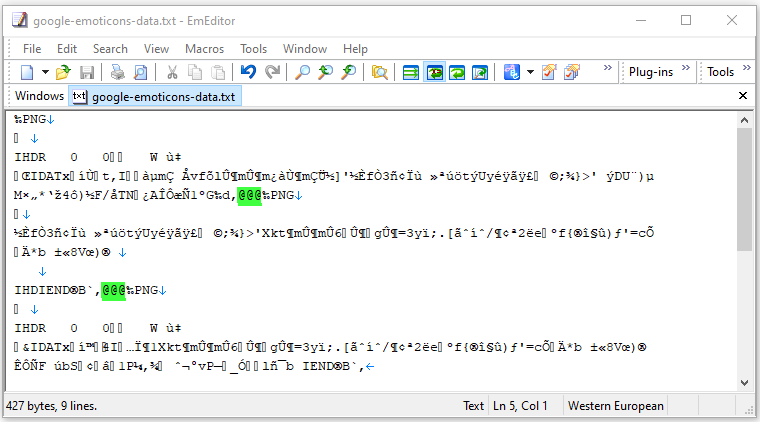
Sử dụng PushbackInputStream để đọc nội dung của file dữ liệu nói trên. Khi bắt gặp byte 64 ( @ ) bạn cần đọc 2 bytes tiếp theo để quyết định cần phải làm gì với byte hiện tại.
PushbackInputStreamEx1.java
package org.o7planning.pushbackinputstream.ex;
import java.io.ByteArrayOutputStream;
import java.io.File;
import java.io.FileOutputStream;
import java.io.IOException;
import java.io.InputStream;
import java.io.PushbackInputStream;
import java.net.URL;
public class PushbackInputStreamEx1 {
private static final String OUT_FOLDER = "/Volumes/Data/test/icons";
private static final String url = "https://s3.o7planning.com/txt/google-emoticons-data.txt";
public static void main(String[] args) throws IOException {
InputStream is = new URL(url).openStream();
PushbackInputStream pis = new PushbackInputStream(is, 2);
ByteArrayOutputStream baos = new ByteArrayOutputStream();
int fileIdx = 0;
int code;
while ((code = pis.read()) != -1) {
if (code == (int)'@') {
int next1 = pis.read();
int next2 = pis.read();
if (next1 == '@' && next2 == '@') {
byte[] imageData = baos.toByteArray();
fileIdx++;
writeToFile(imageData,fileIdx); // Write Image file.
baos = new ByteArrayOutputStream();
} else {
baos.write(code);
pis.unread(next2);
pis.unread(next1);
}
} else {
baos.write(code);
}
}
byte[] imageData = baos.toByteArray();
fileIdx++;
writeToFile(imageData,fileIdx); // Write Image file.
pis.close();
}
private static void writeToFile(byte[] data, int fileIdx) throws IOException {
File file = new File(OUT_FOLDER +"/" + fileIdx + ".png");
file.getParentFile().mkdirs();
System.out.println("Write file: " + file.getAbsolutePath());
FileOutputStream fos = new FileOutputStream(file);
fos.write(data);
fos.close();
}
}Output:
Write file: /Volumes/Data/test/icons/1.png
Write file: /Volumes/Data/test/icons/2.png
Write file: /Volumes/Data/test/icons/3.png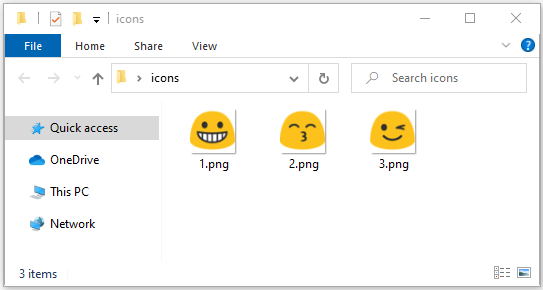
Việc sử dụng một InputStream thông thường để đọc từng byte sẽ tốn rất nhiều thời gian, bạn nên sử dụng BufferedInputStream cải tiến hiệu suất của ví dụ trên:
PushbackInputStreamEx1b.java
package org.o7planning.pushbackinputstream.ex;
import java.io.BufferedInputStream;
import java.io.ByteArrayOutputStream;
import java.io.File;
import java.io.FileOutputStream;
import java.io.IOException;
import java.io.InputStream;
import java.io.PushbackInputStream;
import java.net.URL;
public class PushbackInputStreamEx1b {
private static final String OUT_FOLDER = "/Volumes/Data/test/icons";
private static final String url = "https://s3.o7planning.com/txt/google-emoticons-data.txt";
public static void main(String[] args) throws IOException {
InputStream is = new URL(url).openStream();
// Create BufferedInputStream object.
BufferedInputStream bis = new BufferedInputStream(is);
PushbackInputStream pis = new PushbackInputStream(bis, 2);
ByteArrayOutputStream baos = new ByteArrayOutputStream();
int fileIdx = 0;
int code;
while ((code = pis.read()) != -1) {
if (code == (int)'@') {
int next1 = pis.read();
int next2 = pis.read();
if (next1 == '@' && next2 == '@') {
byte[] imageData = baos.toByteArray();
fileIdx++;
writeToFile(imageData,fileIdx); // Write Image file.
baos = new ByteArrayOutputStream();
} else {
baos.write(code);
pis.unread(next2);
pis.unread(next1);
}
} else {
baos.write(code);
}
}
byte[] imageData = baos.toByteArray();
fileIdx++;
writeToFile(imageData,fileIdx); // Write Image file.
pis.close();
}
private static void writeToFile(byte[] data, int fileIdx) throws IOException {
File file = new File(OUT_FOLDER +"/" + fileIdx + ".png");
file.getParentFile().mkdirs();
System.out.println("Write file: " + file.getAbsolutePath());
FileOutputStream fos = new FileOutputStream(file);
fos.write(data);
fos.close();
}
}Các hướng dẫn Java IO
- Hướng dẫn và ví dụ Java CharArrayWriter
- Hướng dẫn và ví dụ Java FilterReader
- Hướng dẫn và ví dụ Java FilterWriter
- Hướng dẫn và ví dụ Java PrintStream
- Hướng dẫn và ví dụ Java BufferedReader
- Hướng dẫn và ví dụ Java BufferedWriter
- Hướng dẫn và ví dụ Java StringReader
- Hướng dẫn và ví dụ Java StringWriter
- Hướng dẫn và ví dụ Java PipedReader
- Hướng dẫn và ví dụ Java LineNumberReader
- Hướng dẫn và ví dụ Java PushbackReader
- Hướng dẫn và ví dụ Java PrintWriter
- Hướng dẫn sử dụng luồng vào ra nhị phân trong Java
- Hướng dẫn sử dụng luồng vào ra ký tự trong Java
- Hướng dẫn và ví dụ Java BufferedOutputStream
- Hướng dẫn và ví dụ Java ByteArrayOutputStream
- Hướng dẫn và ví dụ Java DataOutputStream
- Hướng dẫn và ví dụ Java PipedInputStream
- Hướng dẫn và ví dụ Java OutputStream
- Hướng dẫn và ví dụ Java ObjectOutputStream
- Hướng dẫn và ví dụ Java PushbackInputStream
- Hướng dẫn và ví dụ Java SequenceInputStream
- Hướng dẫn và ví dụ Java BufferedInputStream
- Hướng dẫn và ví dụ Java Reader
- Hướng dẫn và ví dụ Java Writer
- Hướng dẫn và ví dụ Java FileReader
- Hướng dẫn và ví dụ Java FileWriter
- Hướng dẫn và ví dụ Java CharArrayReader
- Hướng dẫn và ví dụ Java ByteArrayInputStream
- Hướng dẫn và ví dụ Java DataInputStream
- Hướng dẫn và ví dụ Java ObjectInputStream
- Hướng dẫn và ví dụ Java InputStreamReader
- Hướng dẫn và ví dụ Java OutputStreamWriter
- Hướng dẫn và ví dụ Java InputStream
- Hướng dẫn và ví dụ Java FileInputStream
Show More
- Hướng dẫn lập trình Java Servlet/JSP
- Các hướng dẫn Java New IO
- Các hướng dẫn Spring Cloud
- Các hướng dẫn Java Oracle ADF
- Các hướng dẫn Java Collections Framework
- Java cơ bản
- Các hướng dẫn Java Date Time
- Các thư viện mã nguồn mở Java
- Các hướng dẫn Java Web Services
- Các hướng dẫn Struts2 Framework
- Các hướng dẫn Spring Boot
